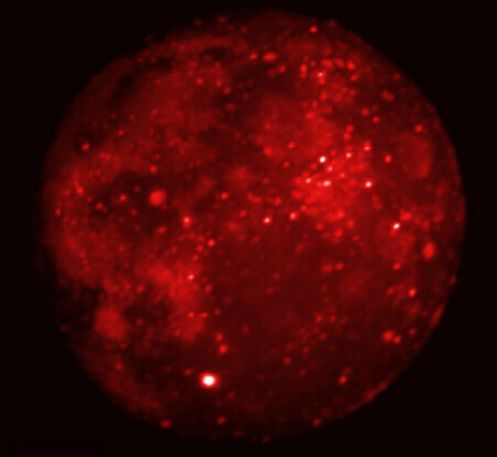Credit & Copyright: DCATT Team,
MSX Project,
BMDO
Explanation:
The total lunar eclipse of September 1996
disappointed many observers in North America who
were cursed with cloudy skies.
However, the
Midcourse
Space Experiment (MSX) satellite had
a spectacular view from Earth orbit and
SPIRIT III,
an on board infrared telescope, was used to
repeatedly image the moon
during the eclipse.
Above is one of
the images taken during the 70 minute totality, the Moon completely
immersed in
the Earth's shadow.
Infrared light
has wavelengths
longer than visible light - human's can not see it but feel it as heat.
The bright spots correspond to the warm areas on the
lunar surface, dark areas are cooler.
The brightest spot below and left of center is the
crater Tycho,
the dark region at the upper right is
the Mare Crisium.
The series of SPIRIT III images allow the determination of cooling
rates for geologically different areas, exploring the physical properties
of the Moon's surface.
Tonight's Lunar eclipse:
Times
| Webcast
| Webcast
| Photo Tips
Totality begins
at 1:06 Universal Time, November 9 (8:06pm EST Nov. 8).
1999 2000 2001 2002 2003 2004 2005 2006 2007 2008 2009 2010 2011 2012 2013 2014 2015 2016 2017 2018 2019 2020 2021 2022 2023 2024 2025 |
Yanvar' Fevral' Mart Aprel' Mai Iyun' Iyul' Avgust Sentyabr' Oktyabr' Noyabr' Dekabr' |
NASA Web Site Statements, Warnings, and Disclaimers
NASA Official: Jay Norris. Specific rights apply.
A service of: LHEA at NASA / GSFC
& Michigan Tech. U.
|
Publikacii s klyuchevymi slovami:
Moon - infrared - lunar eclipse - Luna - infrakrasnoe izluchenie - lunnoe zatmenie
Publikacii so slovami: Moon - infrared - lunar eclipse - Luna - infrakrasnoe izluchenie - lunnoe zatmenie | |
Sm. takzhe:
Vse publikacii na tu zhe temu >> | |
